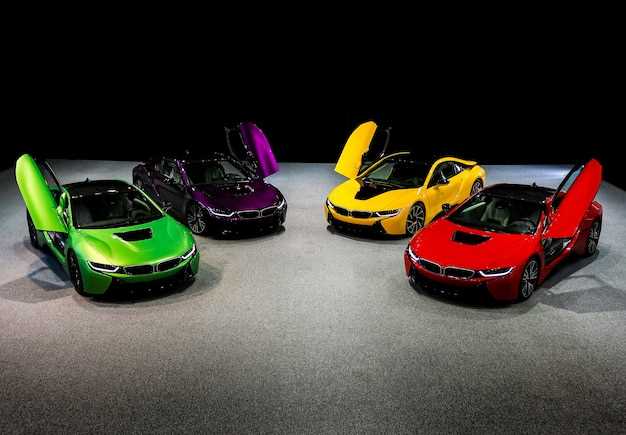
Audi Q4 e-tron vs Ford Mustang Mach-E

The automotive industry is experiencing a significant shift towards electric vehicles, with manufacturers striving to offer models that combine performance, comfort, and cutting-edge technology. Among the standout contenders in this evolving landscape are the Audi Q4 e-tron and the Ford Mustang Mach-E. Both vehicles aim to capture the essence of their respective brands while providing environmentally friendly alternatives.
In this comparison, we will delve into the specifics of the Q4 and Mach-E, examining their design, performance, range, and technological features. The Audi Q4 e-tron stands out with its sleek, modern styling and premium interior, embodying the luxury synonymous with the Audi name. In contrast, the Ford Mustang Mach-E offers a sporty aesthetic that pays homage to the legendary Mustang lineage while incorporating a family-friendly electric SUV format.
As we explore the performance metrics, the Mustang’s spirited driving dynamics will be put against the refined handling characteristics of the Q4. Range anxiety is a consideration for many buyers, so we will also analyze how each model fares in terms of electric range and charging capabilities. Finally, we will review the state-of-the-art technology each vehicle boasts, from infotainment systems to advanced driver-assistance features.
Join us as we dissect these two electric vehicles, aiming to help potential buyers make informed decisions based on key features and specifications. Whether you lean towards the Audi Q4‘s luxury or the Ford Mustang Mach-E‘s performance, this comparison will provide valuable insights into their offerings.
Performance Metrics: Acceleration and Range Analysis

The Audi Q4 e-tron and the Ford Mustang Mach-E represent two distinct approaches to electric vehicle performance. In terms of acceleration, the Mach-E offers impressive figures, with its GT version capable of sprinting from 0 to 60 mph in just around 3.5 seconds. This makes it one of the quickest electric SUVs available on the market today.
On the other hand, the Audi Q4 e-tron also emphasizes performance, particularly in its quattro variants. These models achieve a 0 to 60 mph time of approximately 5.8 seconds, showcasing robust acceleration but not quite matching the Mach-E’s prowess. Audi’s focus on a balanced driving experience makes the Q4 e-tron feel agile, even if its acceleration isn’t class-leading.
When it comes to range, the Ford Mustang Mach-E offers competitive performance, with its extended-range battery options providing up to 300 miles on a single charge, depending on the configuration. This ensures not only acceleration performance but also long-distance capability for daily driving and road trips alike.
Conversely, the Audi Q4 e-tron boasts a commendable range as well, with its highest-rated version achieving around 241 miles on a full charge. While this is less than the Mach-E, Audi’s engineering ensures that the Q4 e-tron delivers efficient performance without compromising driving pleasure.
Ultimately, choosing between the Audi Q4 e-tron and the Ford Mustang Mach-E in terms of performance metrics will depend on individual priorities. Acceleration enthusiasts may gravitate towards the Mach-E for its sporty performance, while those seeking a balanced approach with solid range might prefer the Q4 e-tron.
Interior Features: Space, Comfort, and Technology
The Audi Q4 e-tron offers a spacious cabin with premium materials that elevate the overall driving experience. With generous headroom and legroom, both front and rear passengers can enjoy long journeys without feeling cramped. The minimalist design, combined with intuitive controls, ensures that the focus remains on comfort and convenience. The ambient lighting enhances the atmosphere, allowing users to customize their environment according to their mood.
In contrast, the Ford Mustang Mach-E provides a sporty yet comfortable interior that reflects its performance heritage. The spacious layout promotes a sense of openness, while the supportive seats cater to both daily commutes and weekend adventures. Ford has equipped the Mach-E with cutting-edge tech, including an expansive touchscreen that centralizes vehicle controls, making it user-friendly for everyone. The sizable cargo space also adds to the practicality of the Mach-E for families and active lifestyles.
Both models feature advanced technology to enhance the driving experience. The Q4 e-tron boasts a high-resolution digital cockpit, providing essential information at a glance, while the infotainment system supports seamless smartphone integration. In the Mach-E, Ford’s SYNC system offers an intuitive interface, voice recognition, and over-the-air updates, ensuring the software remains current and functional.
Ultimately, the choice between the Audi Q4 e-tron and the Ford Mustang Mach-E revolves around personal preference for space, comfort, and the type of technology that meets individual needs. Each vehicle brings its own unique interpretation of a modern electric interior, appealing to different segments of the market.
Pricing and Incentives: Cost-Benefit Evaluation for Buyers

The Audi Q4 e-tron and Ford Mustang Mach-E present buyers with attractive options in the electric vehicle market, but they come with differing price points and incentives that may impact purchasing decisions. The base price for the Q4 e-tron generally starts higher than that of the Mach-E, reflecting Audi’s luxury branding and premium features. Buyers should consider the initial investment relative to potential savings on fuel and maintenance over time.
Incentives for electric vehicles vary significantly by region, affecting the net cost for consumers. The Mach-E typically benefits from federal and state tax credits, which can significantly lower the effective price. Depending on the buyer’s location, the value of these incentives could tilt the favor towards the Mustang, especially for budget-conscious consumers seeking to maximize value.
In contrast, while the Q4 e-tron is often perceived as a more premium product, it may qualify for similar incentives as its competitor. Potential buyers should evaluate the total cost of ownership, including factors such as insurance rates, electric charging discounts, and resale value estimates. The Mach-E’s more competitive pricing combined with available incentives makes it appealing for those prioritizing affordability, while the Q4’s brand image and luxury features attract buyers willing to invest in a higher-priced vehicle.
When evaluating the cost-benefit scenario, it’s essential to consider both upfront costs and long-term financial implications. Financing options and leasing deals can further influence affordability. Ultimately, the decision between the Audi Q4 e-tron and Ford Mustang Mach-E may hinge on individual buyer priorities–whether they seek a premium experience or a balance of technology, price, and available incentives.